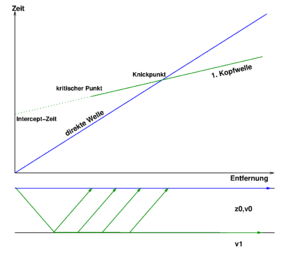Critical point (seismic)
In refraction seismics, the critical point is the location of the first appearance of the head wave in the travel time diagram . The head wave (also called refracted or mintrop wave ) occurs when a seismic wave hits an interface of two layers with different propagation speeds at the critical angle . It spreads along the interface with the velocity v 1 and continuously radiates wave energy, which in turn runs back to the earth's surface at the critical angle (shown in green in the figure).
Since the refracted wave is only generated after the critical angle has been reached, it only occurs after a distance that depends on the speed and the thickness of the layers. Mathematically, the critical distance can be expressed as:
Here x c is the critical distance and z 0 is the layer thickness. i c is the critical angle, which in turn can be calculated from the speeds of both layers:


